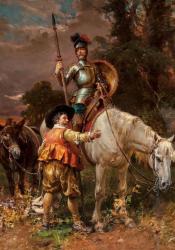"Don Quixote" by Miguel de Cervantes
"Don Quixote," written by Miguel de Cervantes, was published in two parts, the first being in 1605 and the second in 1615 ("Don Quixote" Par.1). It is regarded as being a "parody of chivalric romances...[and]...a prototype of the modern novel" ("Don Quixote" Par.1). Despite this, according to Bruce W. Wardropper in" 'Don Quixote': Story or History?", Cervantes himself never referred to his work as being a novel or a novella instead, "he prefers to call his book an 'historia,'... [which means that then]... [w]e have to deal...with a story masquerading as history" (Wardropper, pp.1). Cervantes's decision to categorize his work as a history suggests that the novel as an artform is innately tied to philosophical questionings of objectivity. Elaborating further on the novel as an artform, Wardropper states that it is the genre's "... awareness of the ill-defined frontier between history and story, between truth and lie, between reality and fiction is what categorizes the novel as [being]...the most self-conscious...[and]... introverted of literary genres" (Wardropper, pp.5). Regardless, Miguel de Cervantes's "Don Quixote" remains a widely influential piece of literature even after the 17th century.
Wardropper, Bruce W. "'Don Quixote': Story or History?" Modern Philology, vol. 63, no. 1, 1965, pp. 1–11. JSTOR, www.jstor.org/stable/436890. Accessed 2 June 2021.
Britannica, The Editors of Encyclopaedia. "Don Quixote." Encyclopedia Britannica, 28 Aug. 2020, https://www.britannica.com/topic/Don-Quixote-novel. Accessed 1 June 2021.

